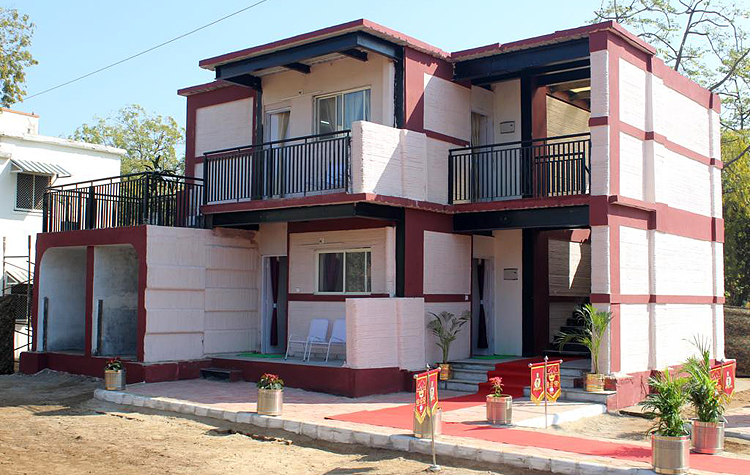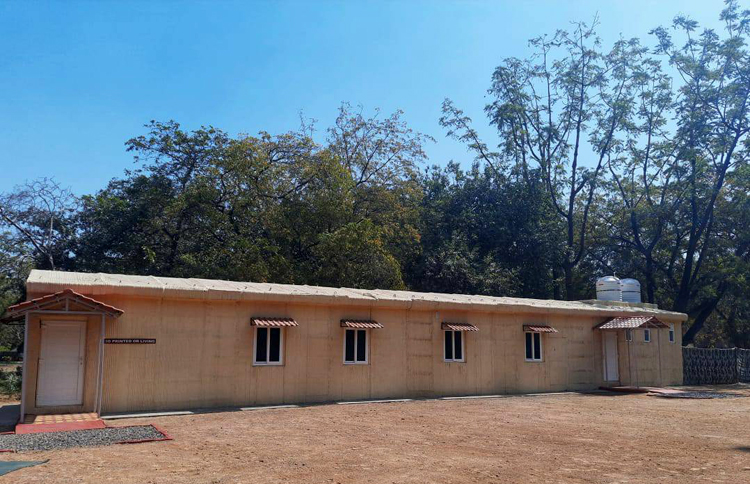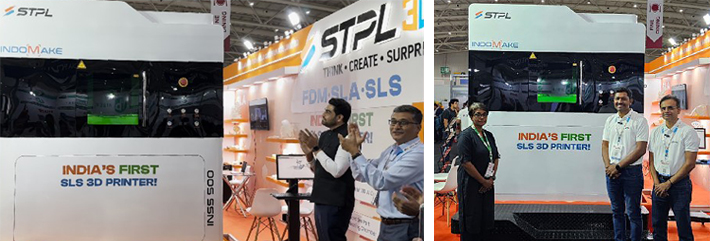INDIAN ARMED FORCES CHIEFS ON
OUR RELENTLESS AND FOCUSED PUBLISHING EFFORTS

SP Guide Publications puts forth a well compiled articulation of issues, pursuits and accomplishments of the Indian Army, over the years

I am confident that SP Guide Publications would continue to inform, inspire and influence.

My compliments to SP Guide Publications for informative and credible reportage on contemporary aerospace issues over the past six decades.
- Interim Defence Budget 2024-25 — An Analysis
- Union Defence budget 2024
- Indian Army: In quest of greater firepower and policy recommendations for gaps
- Indian Army Annual Press Conference 2024
- 6G will transform military-industrial applications
- Tata Boeing Aerospace Delivers 250 AH-64 Apache Fuselages, Manufactured in India
3D Printed Bunkers at LAC
Indian Army pioneers 3D printed structures for building the future with defence innovations
 |
The Author is Former Director General of Information Systems and A Special Forces Veteran, Indian Army |

A Press Trust of India (PTI) release dated December 29, 2022 indicated that the Indian Army had inaugurated its first 3-D Printed House Dwelling Unit (with Ground plus One configuration) for soldiers at Ahmedabad Cantt a day earlier. The dwelling unit measuring 71 sqm with garage space was completed in 12 weeks, using 3D printed foundation, walls and slabs by the Military Engineering Services (MES) in collaboration with MiCoB Pvt Ltd incorporating the latest 3D Rapid Construction Technology. The disaster-resilient structures complies with Zone-3 earthquake specifications and green building norms. The technique utilised a concrete 3D printer that accepts a computerised three-dimensional design and fabricates a 3D structure in a layer-by-layer manner by extruding a specialised type of concrete specifically designed for the purpose.
Indian Army inaugurated its first 3-D Printed House Dwelling Unit for soldiers at Ahmedabad Cantt
Earlier, it was covered in these columns on December 1, 2022 that the Army had conducted a successful trial of permanent defences using 3D printing technology. 3D printing technology uses complex software and a robotic unit that helps in creating a structure through multiple stages from a digital model. Notably, these trials of 3D 'permanent defences' were successfully carried out against a range of weapons from small arms to the main gun of the T-90 tank; the 3D-printed permanent defences withstood direct fire by a T-90 tank from a distance of about 100 metres. These 3D structures are modern, compact, and can be lifted and erected in a few days. Most importantly, erecting these defences saves time, cuts costs and they can also be relocated.
The Indian Army is now in the process of constructing modular, 3D-printed, next generation bunkers to provide better protection to front-line soldiers guarding the country's border with China in the Ladakh sector, as also creating underground facilities for the storage of ammunition at forward locations along the Line of Actual Control (LAC), in addition to building new roads, bridges and tunnels as part of an overarching infrastructure push to strengthen its capabilities, faced with the continuing standoff with China.

Trials for the 3D modular bunkers were successfully conducted in the western sector of Rajasthan, as well as in eastern Ladakh. This project (3D permanent defences) is being implemented by the Corps of Engineers of the Indian Army. These defences can be easily moved by two soldiers if needed as the heaviest component in the structure weighs only 40 kg. Durability and lightness are the benefits of the bunkers. The modules are being built by the Corps of Engineers in partnership with the IITs at Gandhinagar and Madras. The technology startups that are part of the incubation cells of the two IITs have the printers required for this. A 3D modular bunker can be made very quickly.
Military Engineering Services (MES) collaborated with MiCoB Pvt Ltd to utilise the latest 3D Rapid Construction Technology
Creation of permanent defence by the Army using 3D technology saving costs and in short time needs to be compared with the bungled project of all-weather border outposts for the Indo-Tibetan Border Police (ITBP) in Ladakh, which was covered in these columns earlier. The media had reported on September 19, 2021; an infrastructure project reduced to a non-starter after five years of work and investment of crores of rupees, even as the India-China faceoff was continuing since May-June 2020.
The ITBP project involved construction of over 40 integrated Border Outposts (BOPs) announced by the government in 2015. These BOPs were supposed to be the first of their kind in the region with freeze-proof toilets, running water and temperature maintained above 22 degree Celsius at all times. The first BOP, as a pilot for the project, was sanctioned to be built for the ITBP in Lukung, termed as the Gateway to Pangong Tso. This project was awarded to the National Projects Construction Corporation (NPCC), a PSU under the Ministry of Jal Shakti. Five years later, and after spending over 20 crore (just for the pilot project), the project for all practical purposes was declared a failure by the ITBP.
The disaster-resilient structures comply with Zone-3 earthquake specifications and green building norms
News reports of January 27, 2024 state that STPL 3D (India's largest 3D printer manufacturer) has officially unveiled the first 'Made-In-India' SLS 3D printer. The event also showcased advances in FDM and SLA from STLP 3D and was attended by representatives from NCAM India, the Ministry of Electronics and Information Technology, the Automotive Research Association of India (ARAI) and Sahajanad Technologies Pvt Ltd. This is the first time that a 'Made in India' SLS 3D printer has been put out in the market.

The SLS 3D printer is conspicuous with its larger build volume of 500 x 500 x 500 mm and integrates a 100W Co2 laser. Additionally, it has an in-build cleaning chamber for a more efficient and user-friendly post-processing process as well as more streamlined workflows. The company highlights this addition as a sign of its commitment to 'user-friendly and future-ready 3D printing solutions'. Rahul Gaywala, CEO of STPL says, "In the dynamic landscape of 3D printing, the future belongs to innovation and precision. STPL 3D is committed to leading this charge, providing cutting-edge solutions that not only meet present demands but also pave the way for a future where additive manufacturing is synonymous with STPL 3D."
The Indian Army is constructing modular, 3D-printed bunkers for frontline soldiers in Ladakh
India has an expanding list of 3D printing service providers like Imaginarium, Wirpro 3D, 3Ding and THINK3D, among others and the market has shown significant growth. For example, research company 6W research noted in a recent report that the Indian 3D printer market grew 94.89 per cent in shipments in 2022 in comparison to 2021. In another study from xResearch, it was predicted that India's 3D printing market is expected to grow at a CAGR of 20.3 per cent between 2022 and 2023, thus increasing in value from $111.0 million in 2022 to $705.1 million by 2030. The SLS 3D printer is an impressive development in the country as India continues to witness evolution and continued adoption of additive manufacturing.
Interestingly, the US deployed 'Expeditionary Labs' for 3D printing in Afghanistan; 20-foot containers with 3D printers, CNC machines, routers, welders, and more to rapidly produce military equipment parts in battle. America plans the same for future potential conflicts with Russia and China. The US Marine Corps has been experimenting with 3D printing for almost everything; from protective gear to bunkers, reinforced concrete bridges, barracks room, even a medical cast aboard an airborne aircraft. In the ongoing war in Ukraine, Ukrainian forces are using 3D printers to print bodies of grenades filled with shrapnel and explosive material, as well as 3D printing stabilisation fins for drone-dropped grenades. The anti-junta forces in Myanmar are also using 3D printers for semi-automatic firearms.





